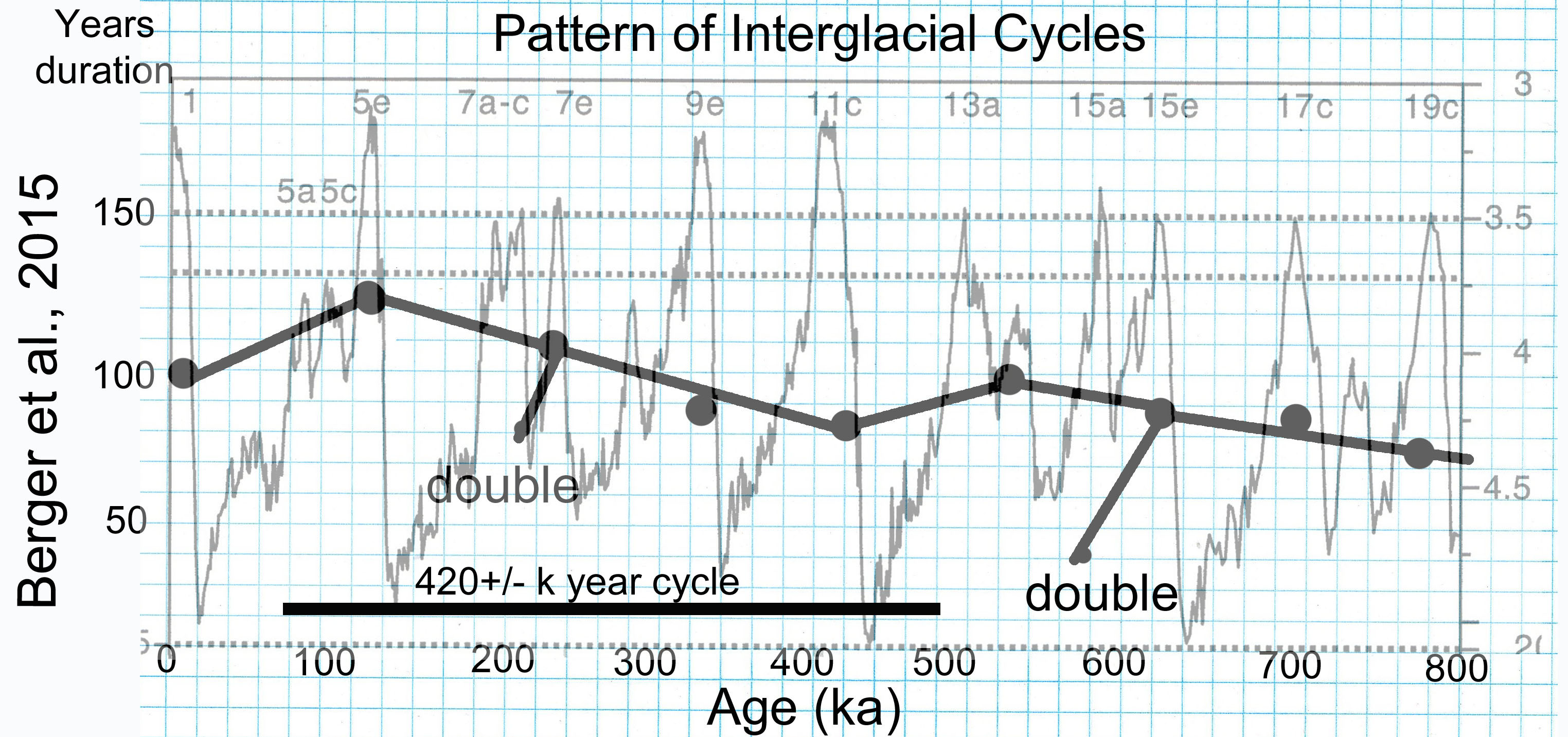
ICE AGE THEORY, PART I
by Bruce Cornet, Ph.D.
Historical Overview
Muller and MacDonald (ref 1) challenged conventional theory for the cause of glacial cycles in 1995 according to the Milankovitch theory, where the 100 kyr glacial cycle is attributed to changes in insolation (solar heating) brought about by variations in the eccentricity of the earth's orbit. They note serious theoretical difficulties with this concept, because insolation variations are too small to drive the cycles, and a predicted strong 400 kyr modulation is not present. They further point out that there are specific disagreements between a strong glacial cycle at both 400 ka and the present, times when the eccentricity modulation is near zero; this conflict is also called the "Stage-11 problem." (ref 2). In addition, improved measurements have uncovered an apparent causality problem: the sudden terminations of the glacial cycles appear to precede the increases in insolation, although this interpretation has been disputed. (ref 3) They suggest that a radical solution is necessary to solve these problems: Muller and MacDonald propose that the 100 kyr glacial cycle is caused not by eccentricity but by the previously ignored parameter: the orbital inclination i, the tilt of the earth's orbital plane.

Muller and MacDonald simplify the cycle intervals to 100 kyr and 400 kyr,
although they vary in duration, as shown in Berger et al. (ref 4) for
Interglacials of the last 800,000 years, and in the graph below from a Report by
Cornet: Comparing Notes
between Triassic-Jurassic Milankovitch Climatic Cycles and Pleistocene Cycles in
Berger et al., 2015.
In the new theory presented here, we concur with Muller
and MacDonald that orbital inclination has been overlooked, but more
importantly, we propose that the Earth rotates on its Orbital Axis (formerly
Precessional Axis) during an Ice Age, but stops rotating on that axis during an
Interglacial period.
This shift in rotation provides a unique
explanation for orbital inclination, and requires an additional mechanism for
stopping Orbital Axis rotation when the Earth’s orbital plane is closely aligned
with the Sun’s ecliptic or Accretion Disc.
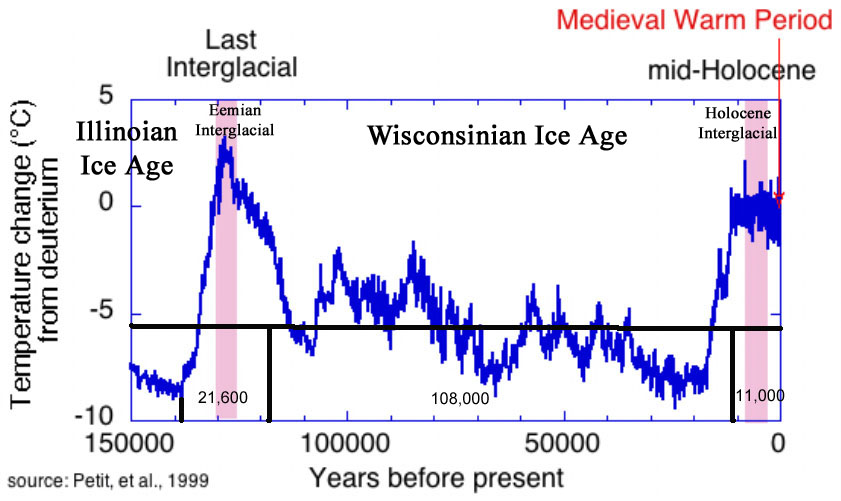
Muller and MacDonald propose that the use of oxygen
isotope ratios, one can determine the percentage of the Earth’s water that is
frozen in ice.
In the diagram below they compare orbital
inclination (solid line, lagged by 33 kyr) with delta(O-18) climate data (dotted
line) for the last 600,000 years from the SPECMAP, compiled from data from five
sea-floor cores.(ref 5) Their figure also shows the orbital inclination i (solid
line), calculated by direct integration of planetary perturbations,(ref 6),
which was transformed to the invariable plane (the plane of symmetry of the
solar system), and shifted to give the best least-squares fit to the delta (O-18)
data.
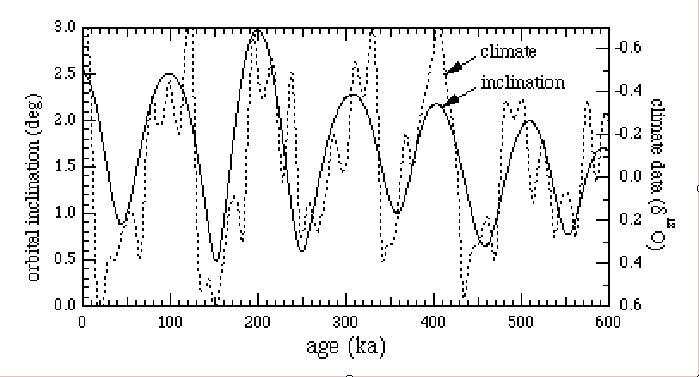
Above:
Comparison of orbital inclination (solid line, lagged by 33 kyr) and delta(O-18)
climate data (dotted line) from SPECMAP
They state that “Only three parameters were adjusted, one for the delay, and two
for the overall scale. For the best fit, i preceded delta(O-18) by 33 ±3 kyr;
since this is positive, there is no causality problem. Similarly, the presence
of a strong variation in i near 400 ka solves the Stage-11 problem.
“The existence of the 100 kyr cycle of orbital inclination does not seem to have
been previously noticed by climatologists or astronomers. It may have been
missed for two reasons. Ever since Milankovitch, the implicit assumption has
been that insolation is the driving force for climate cycles, and insolation is
not directly affected by orbital inclination. Secondly, the 100 kyr cycle is not
evident when i is calculated in the usual reference frame based on the present
orbit of the earth. Only when transformed to the invariable plane (or a plane
near it) does the 100 kyr cycle unmix from the obscuring effect of a strong 70
kyr orbital precession cycle. We note that a 70 kyr cycle has been reported in
delta(O-18) data from other sedimentary samples, and we suggest that this cycle
may be related to orbital precession.
“The only mechanism we have found that could link orbital inclination to climate is extraterrestrial accretion of meteoroids or dust. Such material can be detected in ice and sedimentary rock through analysis of iridium; Walter Alvarez has pointed out that extraterrestrial dust cycles could be detected using He-3. If this mechanism is correct, then a 100 kyr cycle should be seen in ice and sediment records of extraterrestrial accretion." c.f. Imbrie et al. (1984; 1993).
Thinking Outside the Box
The Earth actually has two axis of rotation: Solar Axis and Orbital Axis, but during Ice Age Interglacial Periods, there is little rotation on the Orbital Axis. How do we know this? It has been assumed that the Present is key to the Past, and that the Precession Cycle of 25,766 years was the same during the last Ice Age as it is today.
But what if that is not the case?
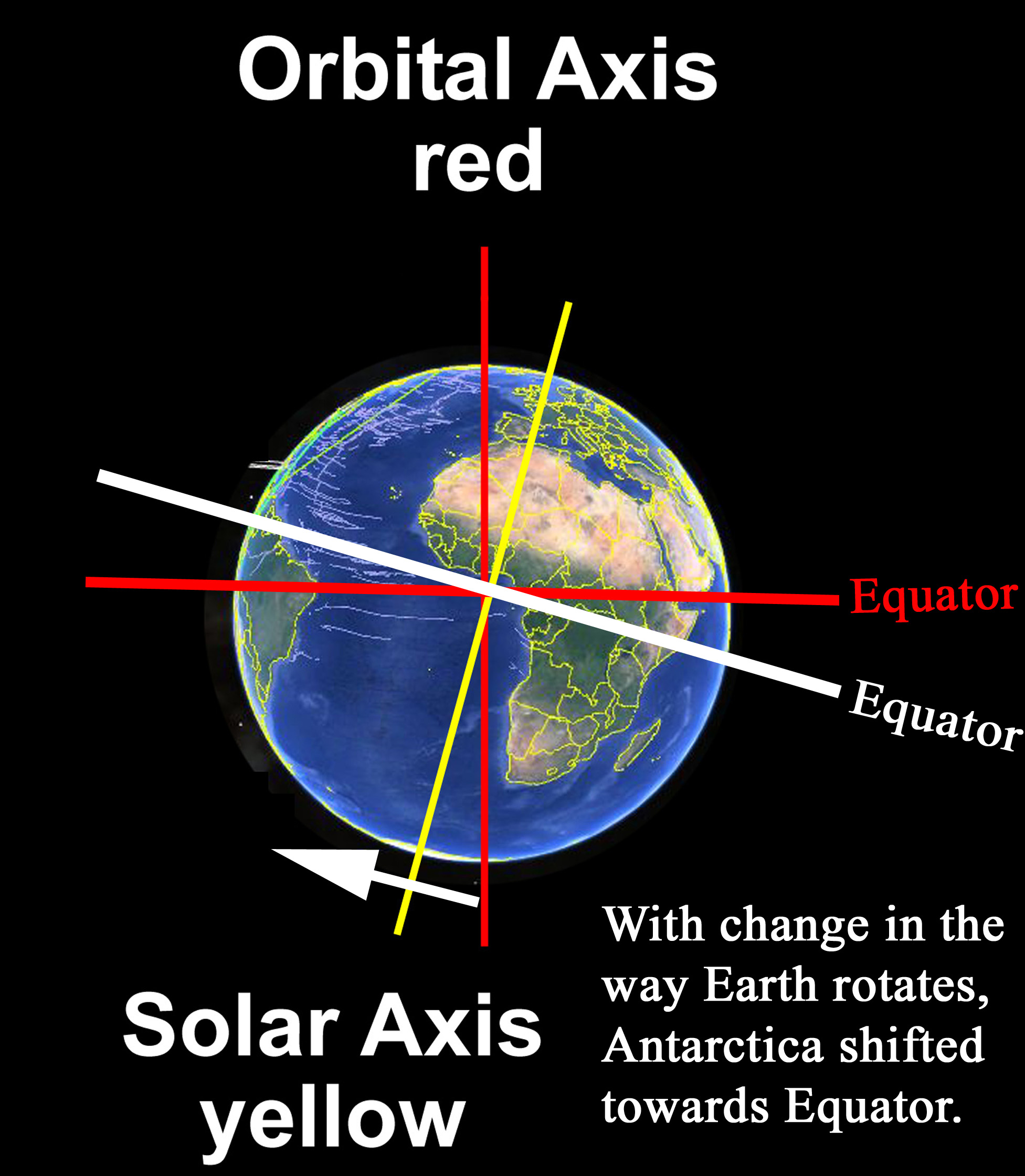
https://www.youtube.com/watch?v=_eMH07Tghs0

Since the changes in Earth spin on its Orbital Axis are very slow, and it takes
as much as 7,000 years for rotation to decrease at the end of an Ice Age period,
does that mean when the Earth's Orbit is aligned
and within the Accretion Zone of the Sun, that the mass of the
Sun is added on to the Earth as if larger weights are added onto the chair
spinner's arms in the video? If that is the case, then the angular momentum of
the Earth would be dramatically decreased during an Interglacial period (chair
spinner slows down). I was
looking at the freedom of the Earth to rotate on its Obital Axis when
its orbit is mostly outside the Accretion Zone,
When the Earth's Orbit is not aligned with the Accretion Zone, how does its
Orbital Axis rotation accelerate?
The eccentric distribution of mass inside Earth
would be pulled by the Sun, thereby causing the Southern Hemisphere
to track the Sun with the South Pole points inside Earth's Orbit. The Earth
would then rotate one complete turn on its Orbital Axis every year, like the
Moon. See the graph above:
Comparison of orbital inclination (solid line, lagged by 33 kyr) and delta(O-18)
climate data (dotted line) from SPECMAP
The Earth rotates differently between Ice Ages and Interglacials due to the wobbling of the Sun on its axis, which is why we have Ice ages alternating with Interglacial warm periods. This relationship was very different before the Pleistocene Period, when at least six climate cycles of different duration were nested within the next larger cycles. We know this because of coring in rocks 190 to 230 million years old (Olsen et al., 1995). We know that a major change in Celestial Mechanics occurred within the Pleistocene, because of ice coring in Antarctica and Arctica (Greenland) that go back 800,000 years (Berger et al., 2015) from the present. My theory is presented below.
Part II will show the influence of our Moon in creating twenty to twenty one 5,140 year cycles within each 108,000 year Ice Age, and how oceanic megatsunamis were created by rapid ice cap melting during and at the end of the Younger Dryas interval, recorded by the ancient Egyptians in the Book of the Dead (Descent of Osiris into the Underworld).
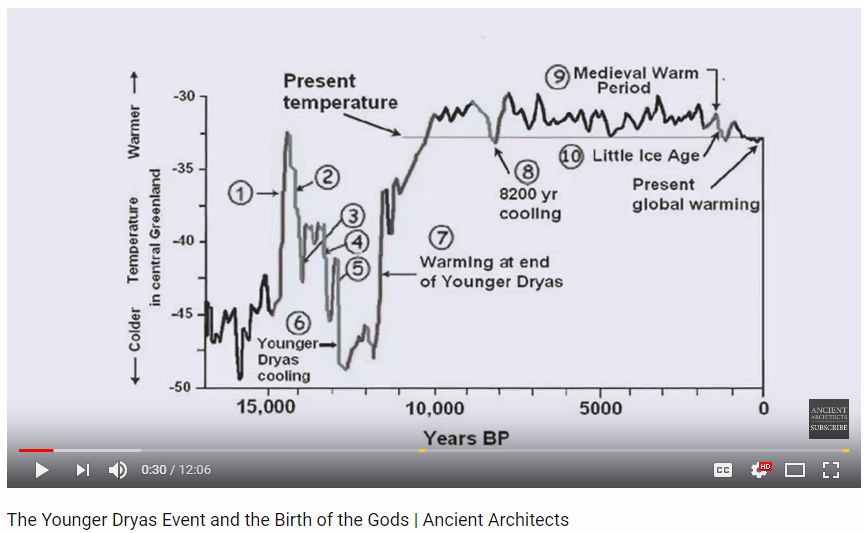
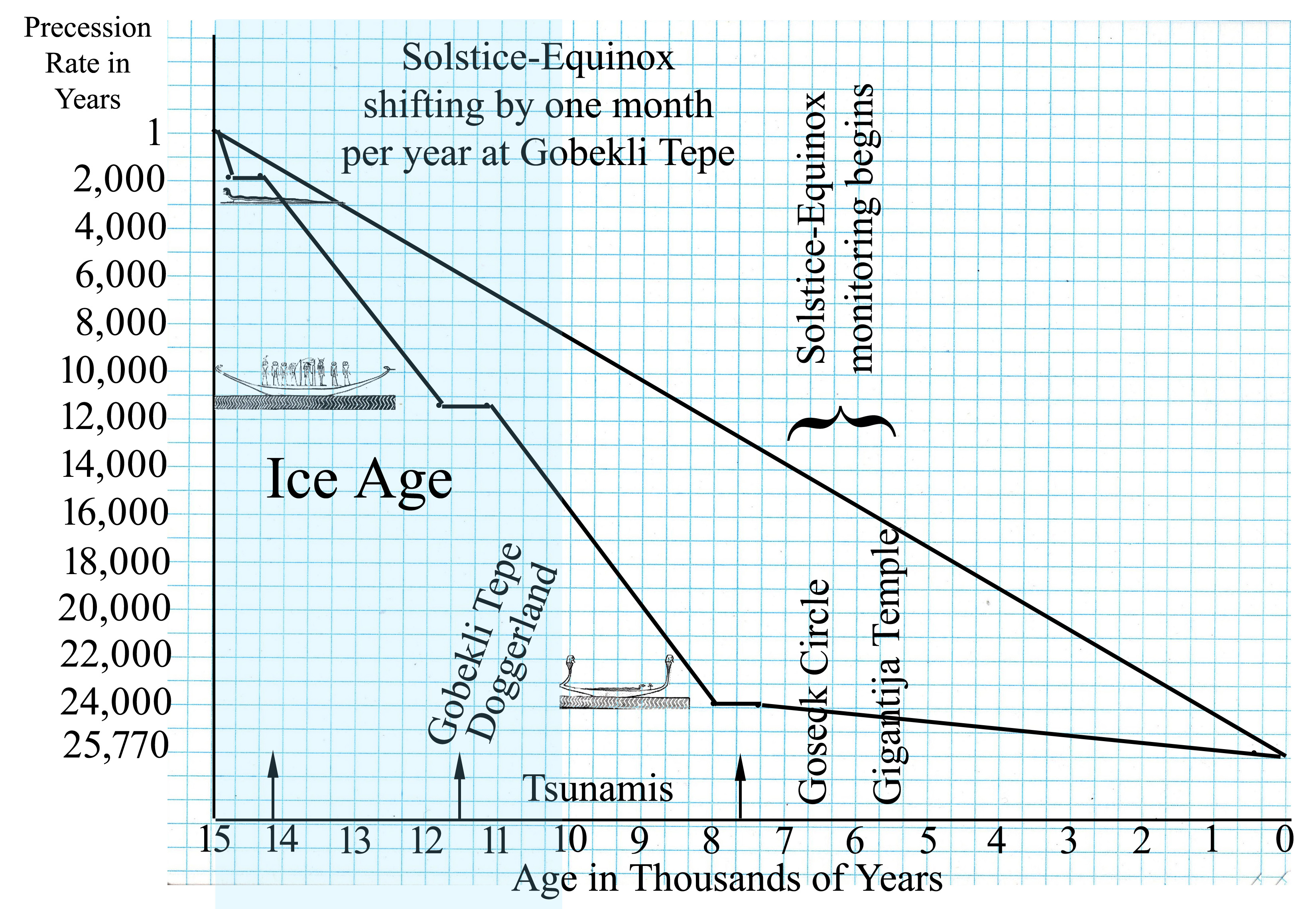
Above: Megatsunamis shown as bars on left with ship drawings on top, correlated with downwards steps in the graph, recorded in the Egyptian Book of the Dead.

During Interglacials the Earth rotates very slowly on its Orbital Axis (North Ecliptic Pole): once every 25,776 years. That is because the Earth's orbit is currently aligned with the Sun's Ecliptic, and is off perfect alignment by only 0.01 degrees (Astronomy Today, 2014: Appendix 3, page A-5, Table 3A). The Earth's rotation on its Orbital Axis (Precessional Axis) is braked by the Sun's North-South equatorial forces within its Accretion Zone. That braking of rotation perpendicular to the Ecliptic allowed clumping of fine matter to form planetoids and planets during the formation of our Solar System. That is why there are four seasons in opposition between hemispheres during Interglacial Periods. That means the Precession of the Equinox as measured today is not constant, but cycles in length four times over a 259,200 period from 1 year during an Ice Age to 25,776 years in the middle of Interglacials.
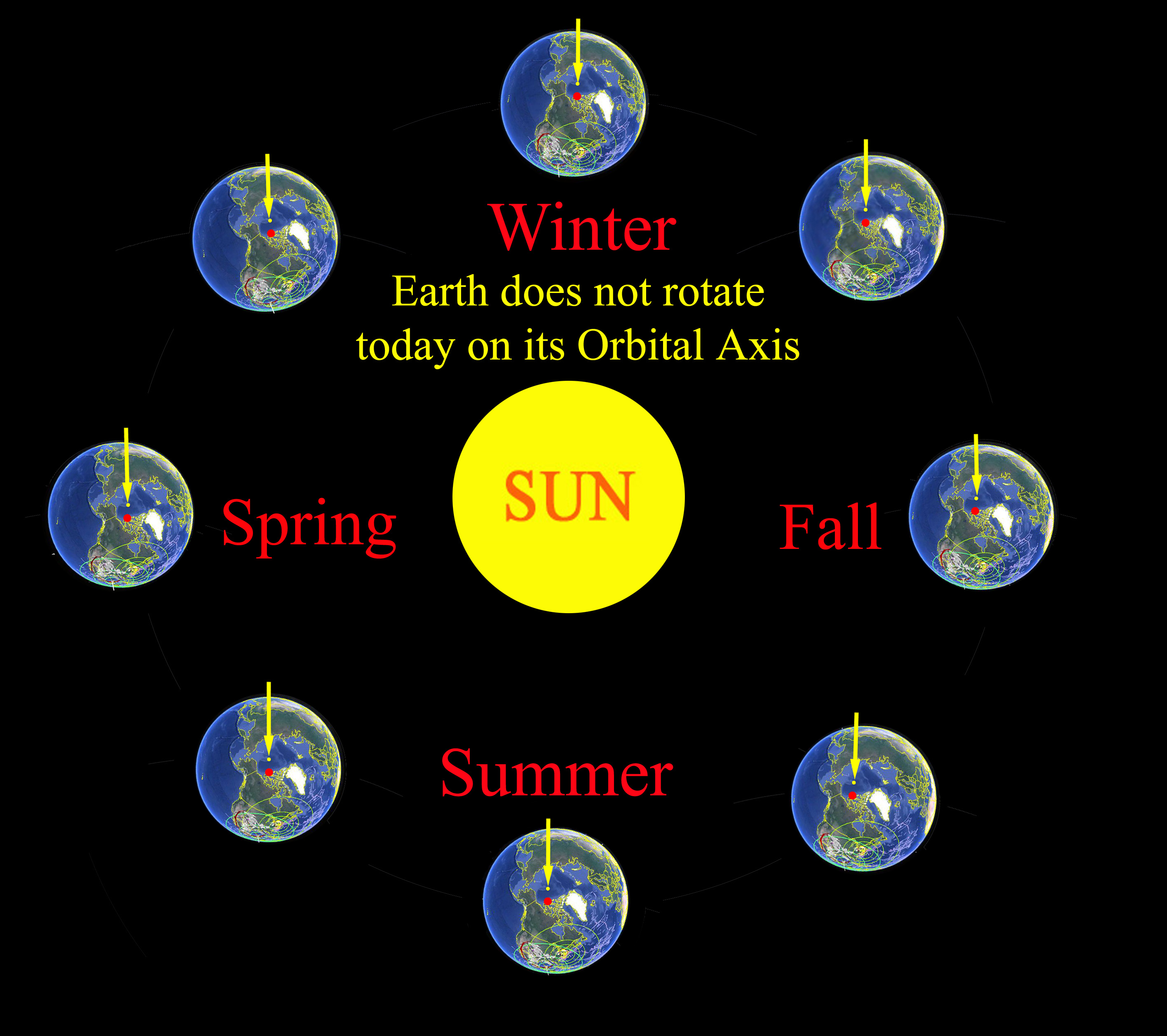

However, during an Ice Age the Earth's Orbit is not aligned with the Accretion Zone, allowing the Earth to rotate freely on its Orbital Axis. Then the Sun's gravity can cause the Earth to rotate like the Moon, rotating once each year on its Orbital Axis. That is because the Earth's mass, like that of the Moon, is not evenly distributed, and the Earth's Core is closer to the South Pole than it is to the North Pole. The Northern Hemisphere contains most of the Continents, and is called the Land World, while the Southern Hemisphere contains most of the Oceans, and is called the Water World. The Earth's Oceanic Crust is much thinner than Continental Crust, meaning that the Earth's Core is further away from the surface in the Northern Hemisphere than it is in the Southern Hemisphere. In addition, the Earth is pear shaped, with the Southern Hemisphere bulging more than the Northern Hemisphere because of the eccentric location of the Core.
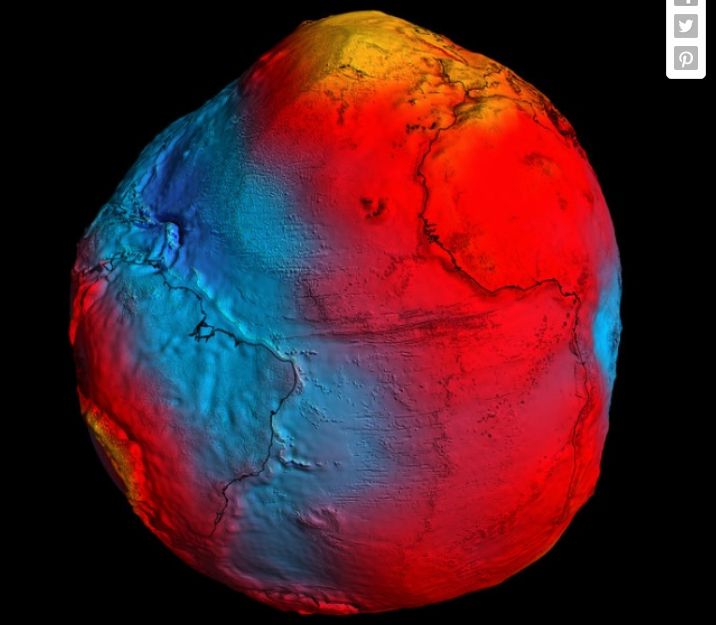
Because the Earth rotates daily on its Solar Axis, which is oriented 25.5 degrees from the Orbital Axis, it is not affected by the forces in the Accretion Zone, and its rotation within the Accretion Zone is not braked. However, the orientation of the Solar Axis to the Sun is controlled by how the South Pole is pulled closer to the Sun by the increased mass of the Southern Hemisphere. That means the South Pole will preferentially point more towards the Sun and be inside the Earth's Orbit all the time during an Ice Age. Hapgood (1955) speculated that the Earth's Crust could slide, and that Antarctica was 17 degrees futher North to account for a warmer climate and loss of ice during the last Ice Age, which was primarily a Northern Hemisphere event. However, if the Earth turned on its Orbital Axis and the South Pole pointed towards the Sun during a yearly orbit, Antarctica would be closer to the Sun, and be up to 17 degrees Latitude closer to the Sun. No Crustal shift in Latitude would be required as proposed by Hapgood.
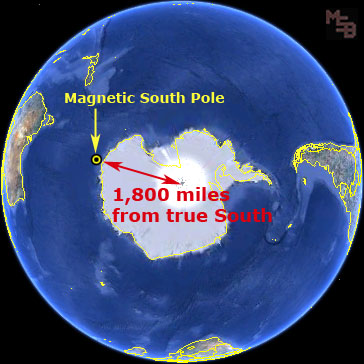

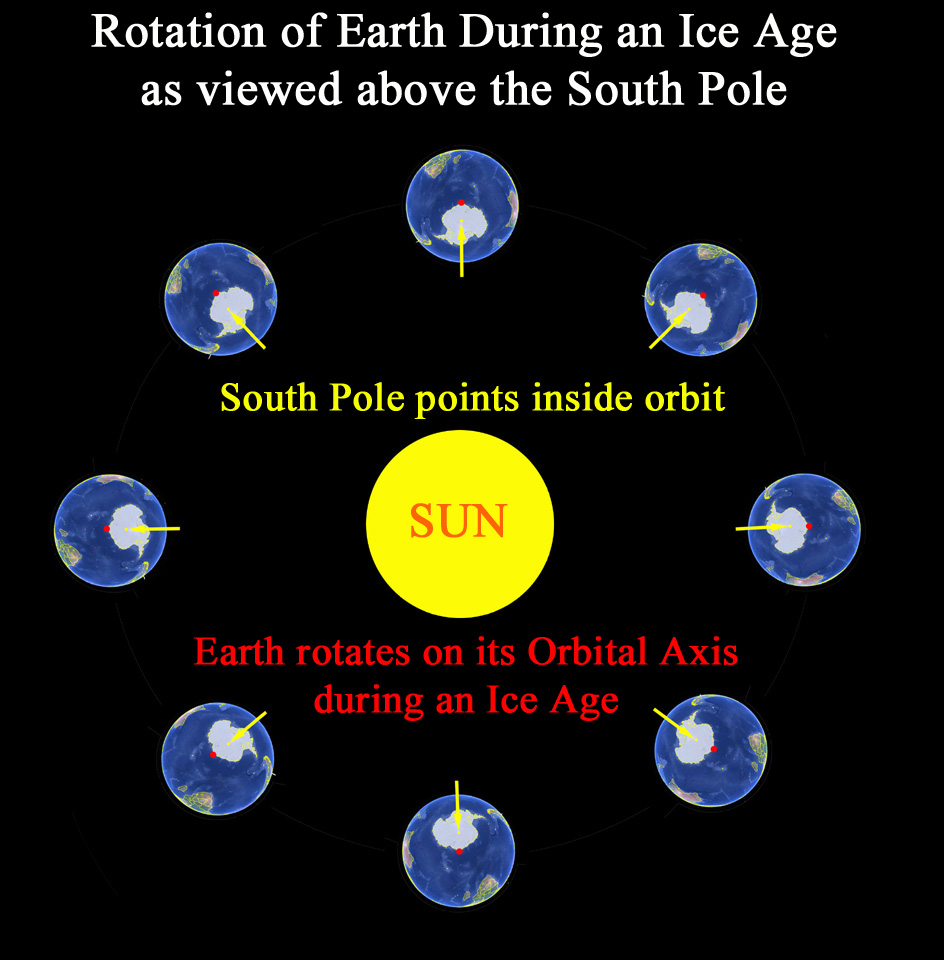
During an Ice Age the Sun never set in Antarctica. That is why ancient maps from the 16th century show Antarctica mostly without ice cover (Hapgood,1955; Hancock, 1995).
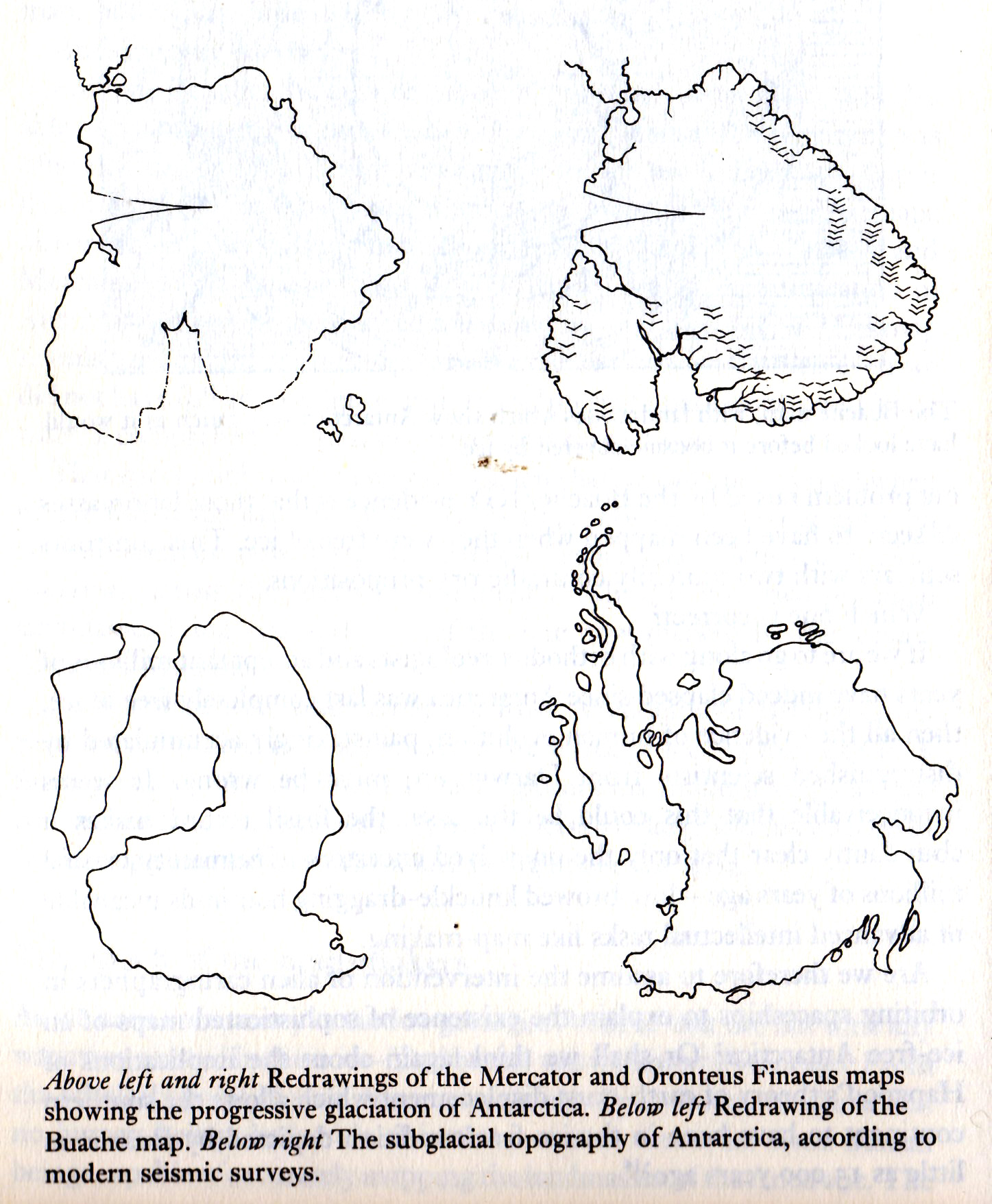
Above Figure from Fingerprints of the Gods, Hancock, 1995.
Conversely, the North Pole will point away from the Sun and be outside the Earth's Orbit and further from the Sun, thereby allowing the North Pole Ice Cap to grow much larger and extend further South than during an Interglacial Period.
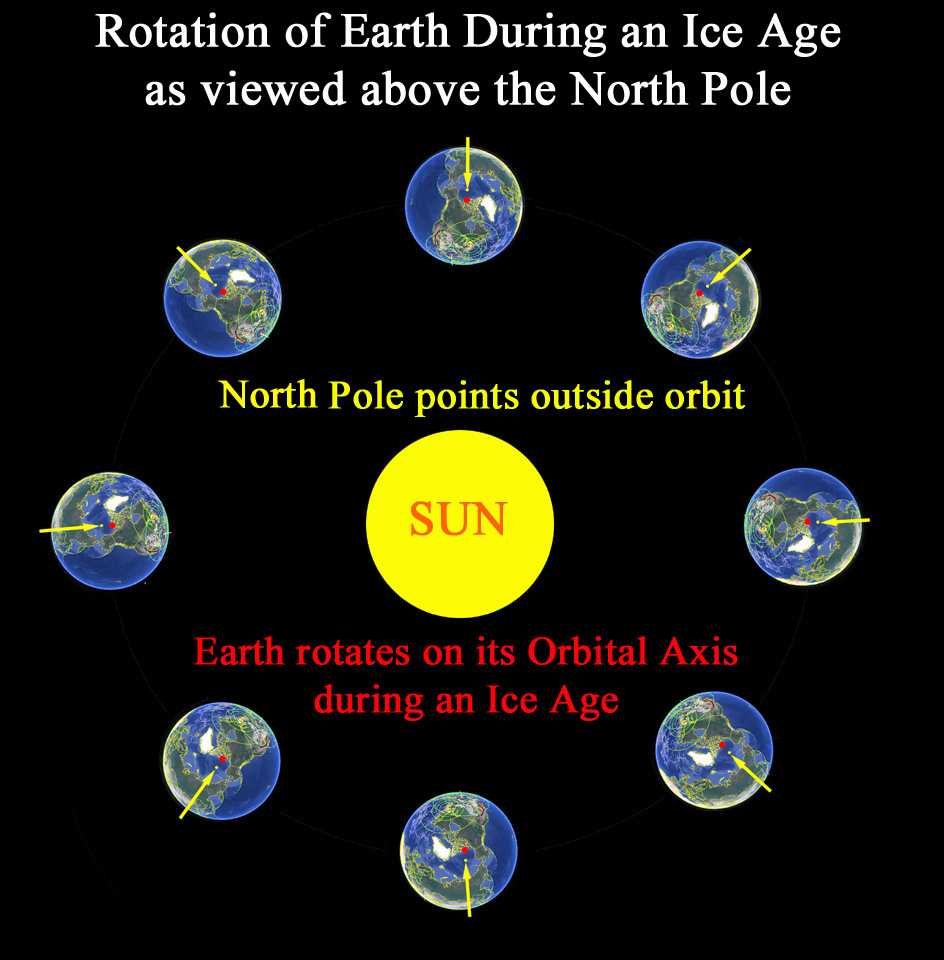
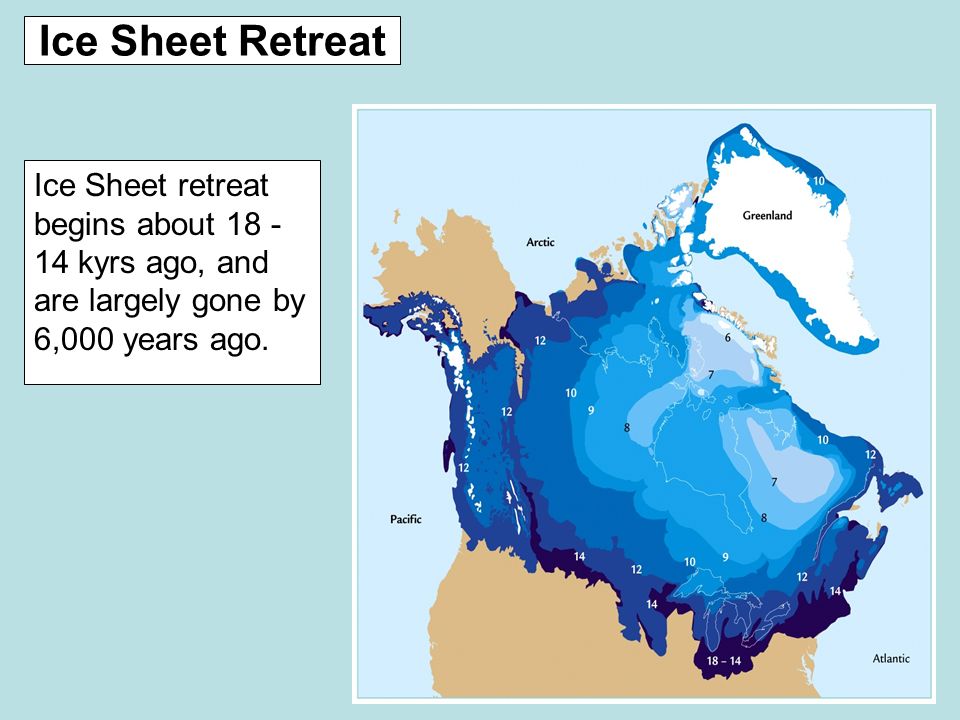
For those unconvince that the Earth would rotate on its Orbital Axis during a Glacial Period of the Pleistocene, look at the repetitive climate cycles recorded in the Ice Cores from both the Antarctic and Arctic locations where as much as 800,000 years of ice has accumulated locally and been preserved.
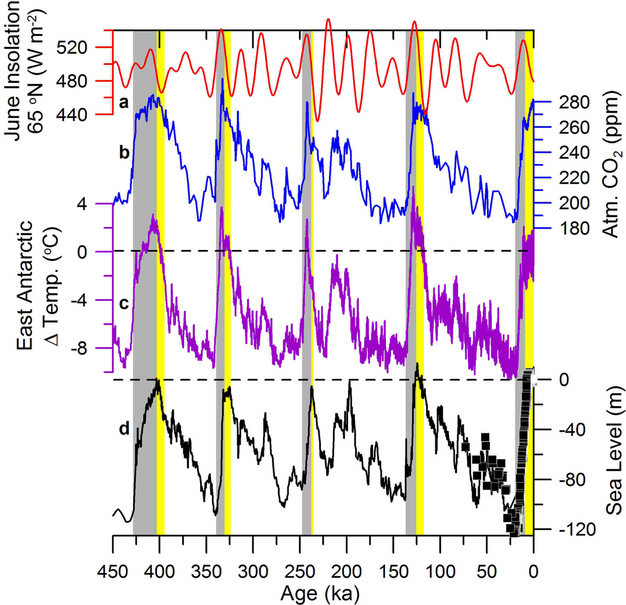

Earth's Moon rotates one complete turn on its Orbital Axis with each orbit of the Earth, because its mass is not centered. The Moon has a metalic core, but it is located closer to the near side of the Moon due to thicker lunar crust on the far side. Thus, the near side is attracted more by gravity to Earth than the far side, and its rotation is perpetuated by tidal wave patterns on Earth.
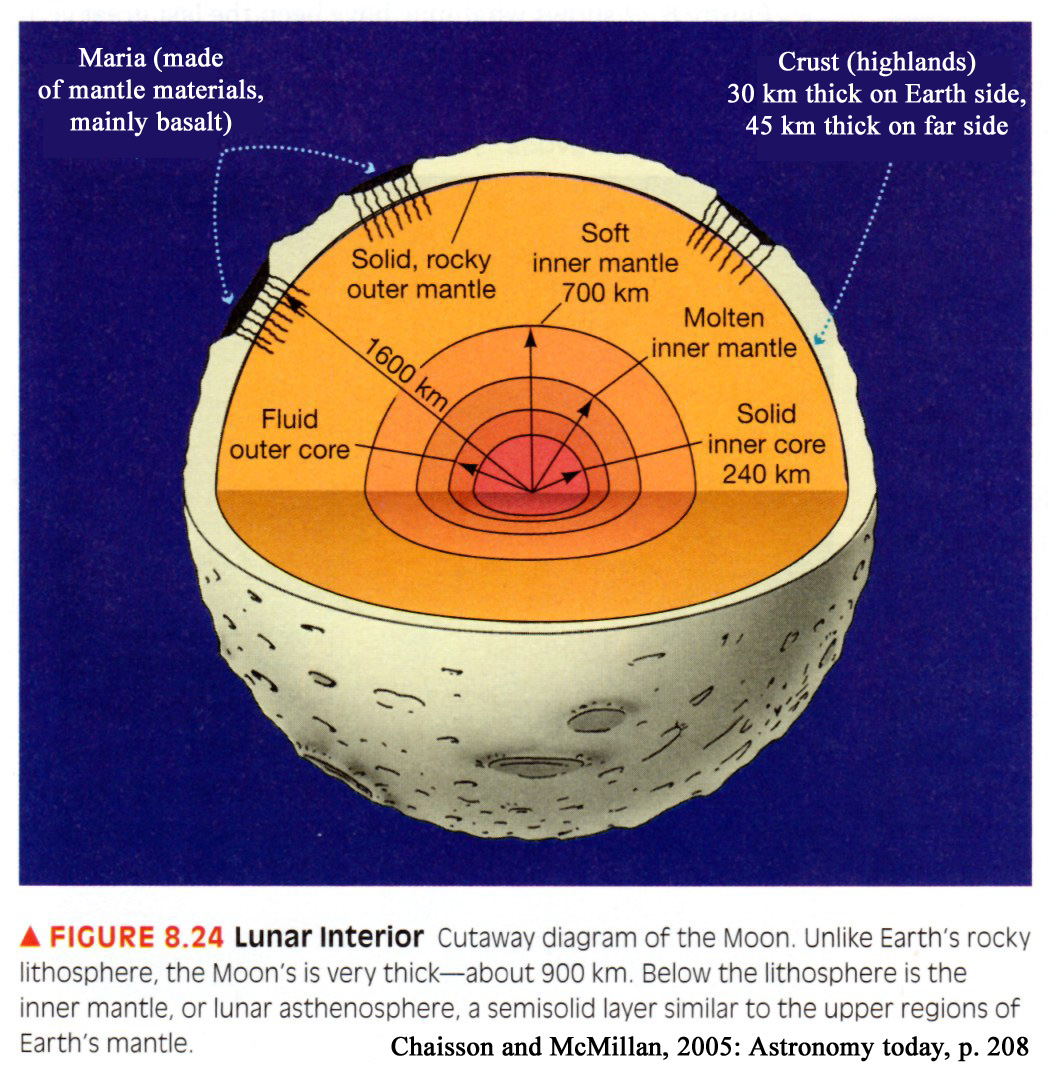
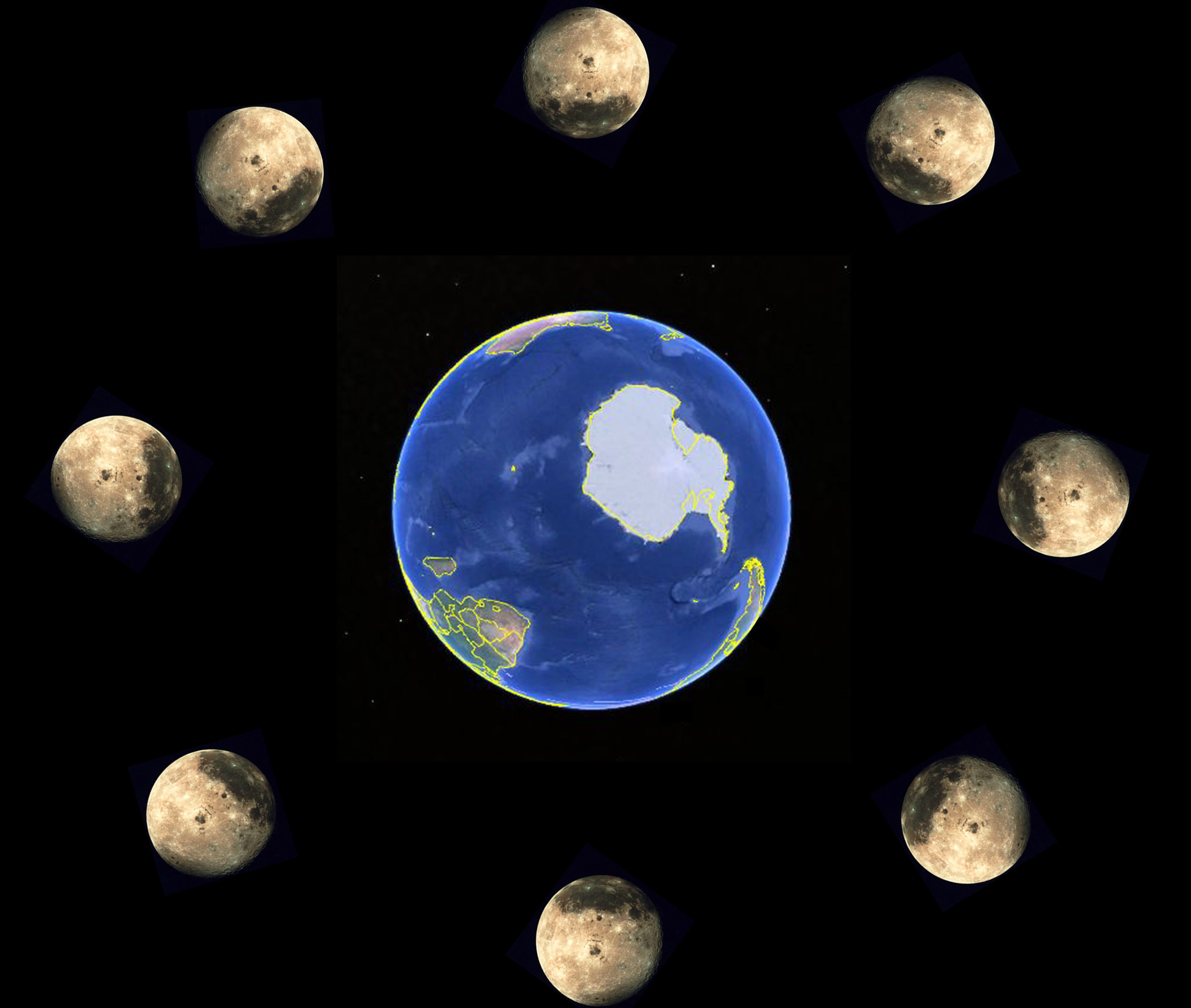
In order to understand this theory, astronomers need to recognize the unusual physical properties within the Sun's Accretion Zone, and how when the Earth's orbit is aligned with that Zone, the Precession Cycle increases from 1 year to 25,766 years. Currently the Earth's Orbit is oriented 0.01 degrees from perfect alignment with the Sun's Ecliptic (Astronomy Today, 2014, Appendix 3, page A-5, Table 3A), but that distance changes as the Sun slowly wobbles on its own axis.
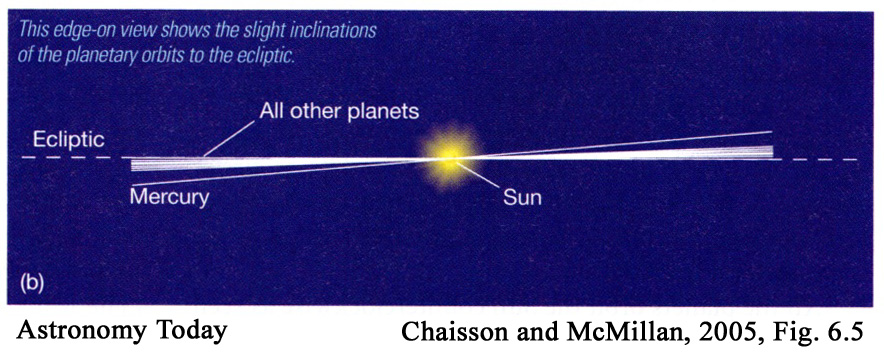
Within the Accretion Zone, the absence of centrifugal motion perpendicular to the Ecliptic, allows small particles with very weak gravity to be attracted to one another. The clumping of Nebular dust to form planetoids and then planets is due to the same restrictive rotation on the rotation of mass parallel with the Accretion Zone. Like brake discs on car wheels, these forces dampen and stop rotation on the Orbita Axis when the Earth's orbit is mostly within the Accretion Zone (currently 0.01 degrees). Since the Earth does not rotate on its Orbital Axis during an Interglacial Period, it has four seasons. This alignment happens twice within a 259,200 year cycle due to the Sun's slow wobble on its own axis. During Ice Ages the Earth does not have seasons like we have today.

When the Earth's orbit is mostly or completely within the Accretion Zone, the Earth cannot rotate on its Orbital Axis due to opposing gravitational spin above and below the Ecliptic, just as hurricanes rotate in opposite directions above and below the Earth's Equator. It is this force within the Accretion Zone that can slow the angular momentum of the Earth on its Orbital Axis down to 1 year annual rotation. When the Earth's alignment is again mostly above and below the Sun's Ecliptic, the Earth is free to rotate on its Orbital Axis, and the Sun's gravity causes the Earth to orient its eccentric mass (mostly in the Southern Hemisphere) towards the Sun. That means the South Pole becomes oriented towards the Sun and inside Earth's orbit.

This relationship between the Sun's wobble and Ice Ages apparently did not exist before the Pleistocene, when climatic Milankovitch cycles were nested within one another, as has been documented for the Late Triassic and Early Jurassic, Newark Supergroup (Olsen et al., 1995).
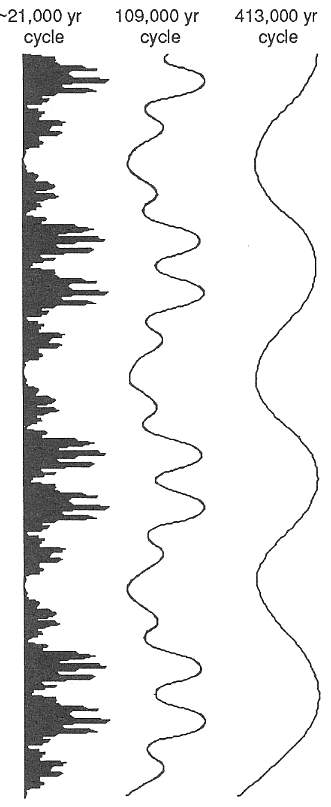
It has been thought that the three
orders of Milankovitch cycles in the Late Triassic-Early Jurassic are
hierarchical.
That is, each shorter cycle is nested within the next
longer cycle as if the longer cycles modulate the shorter cycles.
And it is true that the longer cycles contain
shorter cycles as illustrated in the diagram above from the study of cores from
the Newark basin (Olsen et al., 1996).
In their graph for Figure 4 Berger et al. (2015)
imply this nested interdependent
relationship.
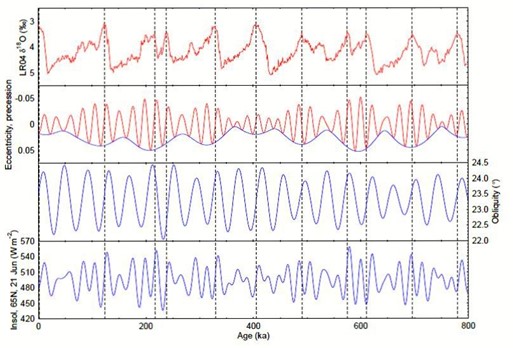
Something radical happened at the beginning of the Pleistocene Period, when instead of longer cycles being multiples of shorter cycles (21,000 x 5 = 109,000 x 4 = 413,000), the shorter 21,600 year cycle alternates with the next larger 108,000 yr cycle, and the 108,000 year cycle is divided up into 21 cycles of approximately 5,140 years each. So, what major changes in our Solar System occurred two million years ago? Did the Sun begin to wobble more?
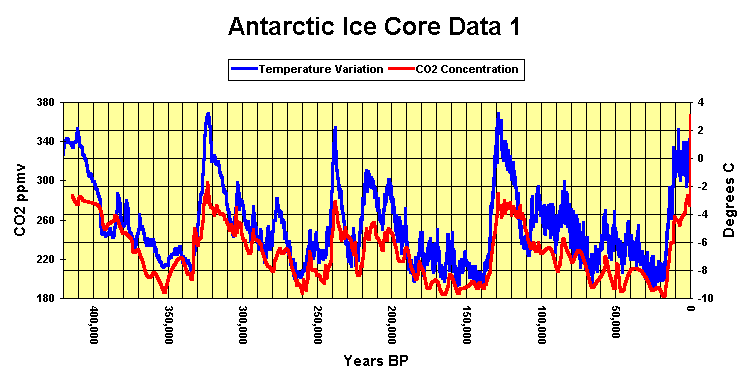
When one examines the composition of Glacial cycles, they do not seem to be made up of any obvious (repetitious) 20k or 21k climatic cycles. Instead, the Antarctic ice cores show that the Wisconsinian Glacial cycle is made up of short ~5,140 year cycles – 21 of them to be exact (av. 5,140 x 21 = ~108,000). And that short period cycle is very close to the Mayan Long Year, the longest period cycle of the Mayan calendar. Did the Mayans know something we only recently rediscovered in the ice cores?
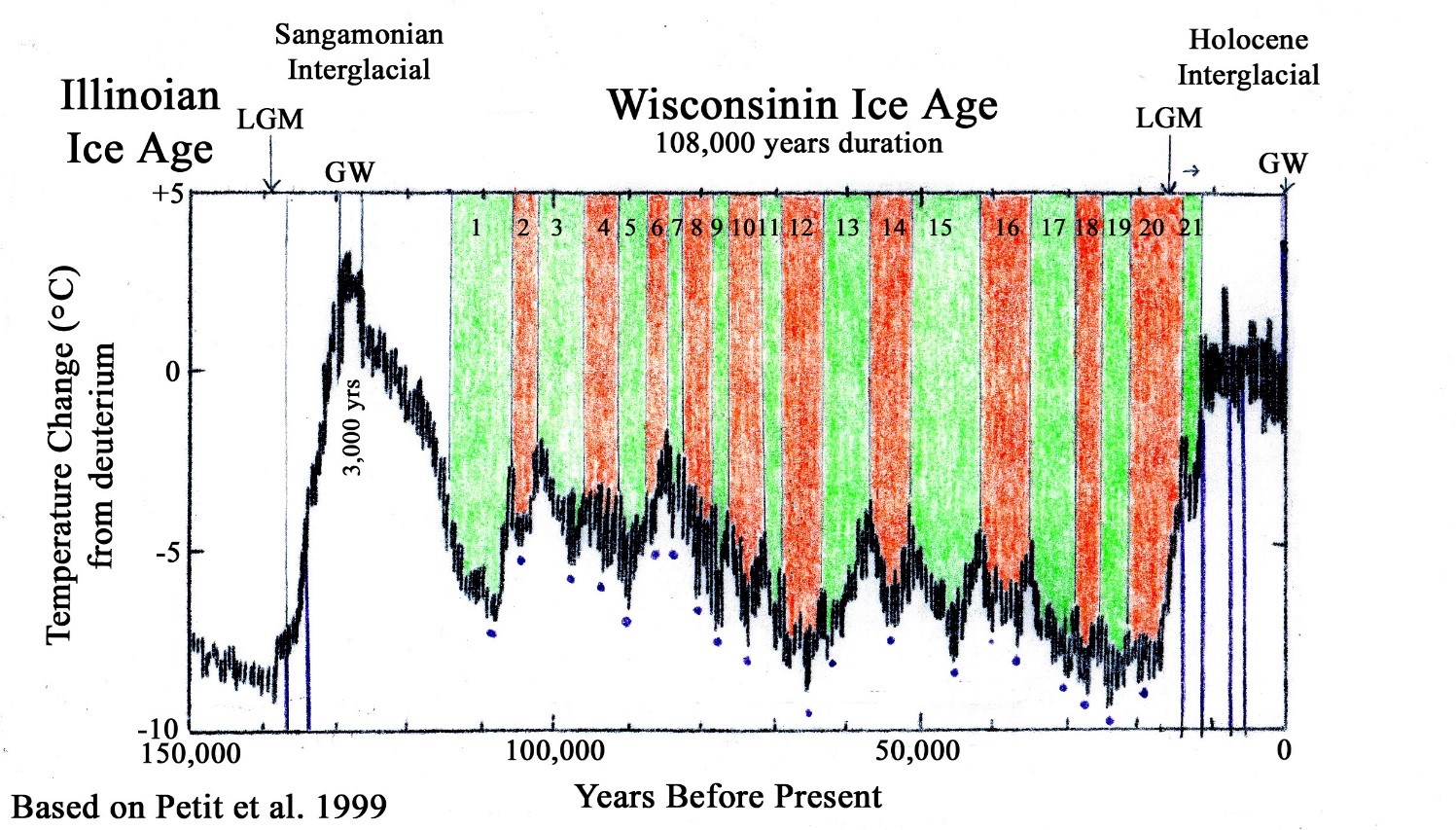
REFERENCES
1. R. A. Muller and G. J. MacDonald, Nature 377, 107-8, (14 September 1995).
2. J. Imbrie et al., Paleoceanography 8, 699-735 (1993).
3. I. J. Winograd et al, Science 258, 255-260 (1992); B. J. Szabo et al.,
Science 266, 1994; J. Imbrie et al., Nature 363, 531-533 (1993); I. J. Winograd
and J. Landwehr, USGS Open-File report 93-357, Reston VA (1993); W. S. Broecker,
Nature 359, 779-780 (1992); N. Shackleton, Nature 362, 596 (1993); K. Ludwig et
al., Nature 362, 596 (1993); C. Emiliani, Nature 364, 583 (1993); J. Landwehr et
al., Science 368, 594 (1994).
4. A. Berger, J.O. Grimalt, H. Rashid, N. Vasquez Ráveiros, Reviews of
Geophysics (November 2015).
5. J. J. Imbrie et al., in Milankovitch and Climate, Part 1, (eds. A. L. Berger
et al.), pp. 269-305. D. Reidel (1984).
6. T. R. Quinn, S. Tremaine, M. Duncan, Astron. Jour. 101, 2287-2305 (1991).
7.
P.
E. Olsen, D. V. Kent, B. Cornet, W. K. Witte, and R. W. Schlische,
Geol. Soc.
Amer.
Bull. (January 1996).
Copyright B. Cornet 2021
Date this web page was last modified:
10/07/21